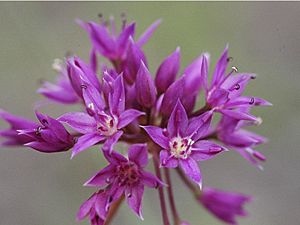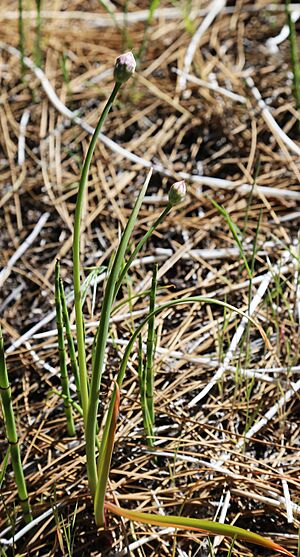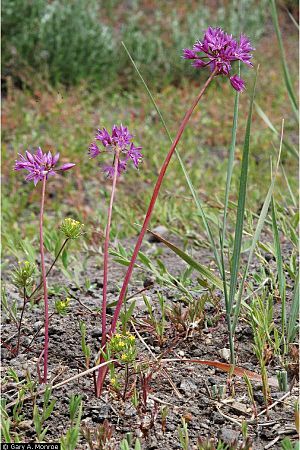Twincrest onion facts for kids
Quick facts for kids Twincrest onion |
|
|---|---|
 |
|
| Flowers | |
| Scientific classification |
The Twincrest onion (scientific name: Allium bisceptrum), also called the aspen onion, is a wild plant that grows high up in the mountains of the western United States. This plant is a perennial, meaning it lives for more than two years. It likes damp, shady places or open meadows. You can find it in states like California, Arizona, New Mexico, Nevada, Oregon, Washington, Idaho, and Utah.
People sometimes use the Twincrest onion for cooking because its leaves can have a very strong smell and taste. Some Native American groups even say a prayer before picking the leaves. Many animals in these areas, like elk, black bears, and prairie dogs, enjoy eating the bulbs of these wild onions.
Contents
What Does the Twincrest Onion Look Like?
The Twincrest onion grows in high places, usually between 6,500 and 9,500 feet (2,000 to 2,900 meters) above sea level. It can grow to be about 4 to 16 inches (10 to 40 cm) tall.
- Bulbs: The onion bulbs are round or egg-shaped. They are light in color and have a strong smell when you cut them.
- Flowers: The flowers grow in clusters and are about 0.4 to 0.6 inches (10 to 15 mm) long. They can be different shades of purple or pink. Each flower has six pointed petals, often with a darker stripe.
- Leaves: The plant usually has two long, flat leaves. These leaves stay green longer than most other onion plants. If you scratch them, they give off a smell.
Where Does the Twincrest Onion Live?
The Twincrest onion grows in mixed forests, which have both pine trees and other types of trees. It also likes wet areas near rivers or streams, and in aspen tree groves or open meadows.
In California, you can find this onion in many counties, especially in the mountains. It also grows widely in Nevada, Utah, Arizona, southeastern Oregon, and southern Idaho. Sometimes, you can find small groups of them in northern Idaho and southeastern Washington.
How to Grow and Use Twincrest Onions
Twincrest onions grow well in cold weather at high elevations. You can plant their seeds outside in the early fall. They don't need to be kept warm during winter. In fact, if winters are too warm, the plants might need to be kept cooler to help them grow.
- Planting Seeds: The soil should drain well, meaning it shouldn't stay too wet. Plant about four to five seeds per square foot of soil. You usually don't need to water them much at first, unless the soil is very dry. Rainwater is often enough until spring. When spring comes, give them about two inches of water each week.
- Growing Conditions: Wild onions can grow in sunlight, but they prefer shady spots. Keep the soil moist, but not too wet. It can take three to five years for a plant grown from seed to produce flowers.
- Planting Bulbs: You can also plant the bulbs (the underground part) of the Twincrest onion. Plants grown from bulbs might flower faster than those grown from seeds. Pick bulbs from mature plants and store them in a dry place, like paper bags with dry peat moss.
- Bulb Planting Time: The best time to plant bulbs is in late fall, when the first frost arrives. Plant them in acidic potting soil mixed with sand and humus for good drainage.
- Bulb Care: Make sure the bulbs don't get too much water. They will start to grow on their own in the spring. Once they start growing, water them at least once a week. If it's a dry week, water them twice. Adding a liquid fertilizer can help them grow stronger. You can stop watering when the leaves start to turn yellow.
Twincrest Onions and Native American Culture
The Washoe people are a Native American group who gather Twincrest onions. When they harvest, they make sure to leave some plants untouched. This helps the plants keep growing and making seeds year after year. They also don't dig up all the bulbs, so the plants can continue to grow in the same spot.
Many Native American groups still use the Twincrest onion today. These include the Nevada Northern Paiute, Gosiute, Northern Ute, and Washoe. The Washoe use the leaves and green parts of the plant as a spice to flavor their food. They pick the young leaves and stems in early spring, after the snow melts. These young parts are the tastiest, with flavors that can be mild or strong. The Washoe sometimes pray before picking these leaves, hoping for a good harvest. The leaves are similar to chives you might buy at a store. You can eat them raw or cook them with meats and other vegetables.
Animals That Eat Twincrest Onions
Wild animals like elk, black bears, white-tailed prairie dogs, and mantled ground squirrels eat the bulbs of wild onions. Some farm animals, like cattle and sheep, also graze on these plants.
Images for kids
See also
 In Spanish: Allium bisceptrum para niños
In Spanish: Allium bisceptrum para niños






